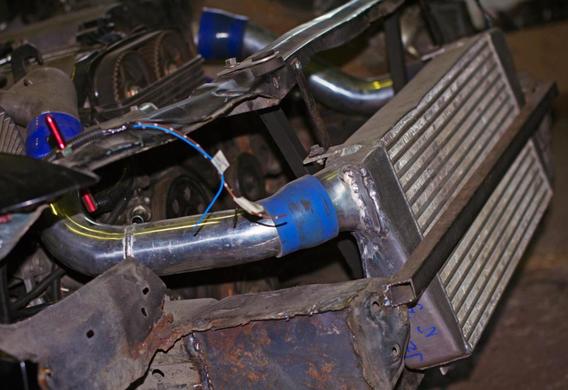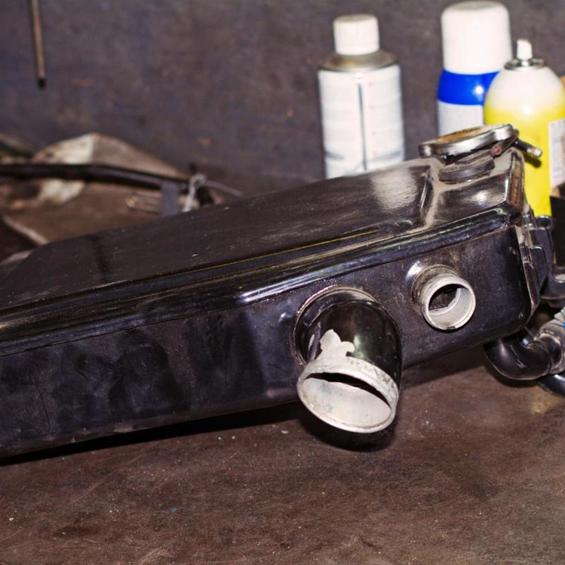
The radiator is a radiator that is cooled after compression in the turbocharger or air compressor. Its task is to remove the maximum amount of heat without the loss of air pressure and increased inertia of the flow. History of the appearance of the intercululaire
History of the appearance of the intercululaire
Iterkulers, or intermediate chillers, began to use turbochargers in the construction of aircraft, ship and locomotive engines back in the 1930s. Oppressors at the time were unwieldy, their wings were too heavy and inert. It took a relatively long time to spin the wingspan to reach the right pressure. Because of this, it was impossible to use turbochargers on engines that were constantly changing during operation-the turbine was unable to keep up with the changes in conditions.
The liquid-cooling intercooler is used on Shelby GT500 2005-2007. His advantage is a small gabarita
The problem was solved with the appearance of light, ceramic porcelain, rapidly growing to very high speed. The turbified petrol engines started in the seventies after the superchargers appeared on Formula 1 racing cars. During the following decades, the inscription "turbo" in the trunk has become a cult. Each producer tried to have at least one model with a turbo engine in its ruler.
About the same years, the bulk introduction of small-volume diesel engines started in passenger cars. Atmospheric diesel engines were economical, but could not compete with petrol for horsepower. Soon the manufacturers realized that the lack of dynamic characteristics of the diesel oil could be successfully compensated by the turbine installation. Since the interculler is part of the set of mandatory structural elements of the turbocharging system of both petrol and diesel engines, it quickly ceased to be exotic and became a privy detail, of the existence of which is known to practically all motorists.
Interkler device and operating principle
Any supercharger, whether a mechanical compressor or a turbocharger, has one serious structural disadvantage: the air pummeled into the cylinders is too much heated during compression. In accordance with the laws of physics, the higher the air temperature, the less the density and therefore the mass. Thus, even with very compressed hot air, it would be more difficult to fill the cylinders in the same volume than if it were cold. Since it is the mass of air that is important to increase the efficiency of combustion, cooling it on the way to the combustion chamber is an important task. Engineers, faced with this problem, soon concluded that the air cooling system with the intermediate radiator could be a good solution, and it was not wrong. If there is an interculler system, the engine power can be increased by 5-25%.
Due to lack of space in front of the radiator, a large volume intercooler has to bear it in front of the bumper, making it a target for stones
The interculler shall be placed between the intake manifold and the supercharger. It is the radiator, the same as in the cooling system, except that it is not antifreeze, but air. The total area of the radiator is very high, allowing for the effective discharge of heat. In most cases, the intercooler is installed in front of the engine cooling radiator to ensure contact with the flow of the running air during the movement. But in some cars they may also be located in other places, for example under the wing. In the uncotheed turbated modifications of Subaru, the intercull is above the engine, and the airflow enters it through the tort in the bonnet. The same design was applied in the turbo-bated MINI Cooper S 2003.
Methods of increasing the efficiency of the interculer
In order to increase the efficiency of the interculer, sports cars sometimes use the irrigation of heat exchanger with water. When evaporation of the water in the hundredth of the radiator, cooling is more effective. The sprayer, for example, is installed on all Subaru Impreza WRX STI (including those supplied to Russia). In the trunk of the car there is a single tank volume of 12 liters: the water is fed into the sprayer by an electric motor, and the system is controlled by pressing the button on the dashboard.
Some modern vehicles use intercooler with additional liquid cooling. A heat exchanger in which the coolant circulates is installed at the intake path.

It is important to understand that this design requires an additional cooling loop, leading to a more complex system. To cool the liquid, you have to install a separate radiator; additional pipes and a pump for forced circulation of antifreeze will be displayed. This design is implemented, for example, by the Volkswagen Golf VI with motor 1.4 TSI. Advantage and disadvantages of interculling
Advantage and disadvantages of interculling
Thanks to the interculer, the power of the engine is significantly increased. Due to the better filling of cylinders, the fuel burns much more efficiently. As a result, fuel consumption is reduced and the exhaust gases become less toxic.
An unconventional "hump" on the hood of some sports cars is an air intake to create an air flow to the upper part of the engine
However, the use of the interculer has its own shortcomings. The heat exchanger and the tube occupy much space in the subspace. The interculler, especially in the case of the installation at the nasal part of the car, becomes a target for small stones and often goes out of service, which increases the cost of car maintenance. Even in a light traffic accident, the interculling installed at the nasal part is destroyed.
Interculling
The design of the interculer is quite simple and does not require special care. The most common problems are the burst of the pipe or even the heat exchanger itself due to high pressure. If this occurs, the engine power falls sharply and the fuel consumption increases.
The intermediate chiller shall be cleaned periodically, as is the radiator of the engine cooling system. Pooh, insects and other small debris would slaughter the honeycomb and degrade the efficiency of its work. In no case can high-pressure devices be used, as the thin walls of cooling units may be used.







